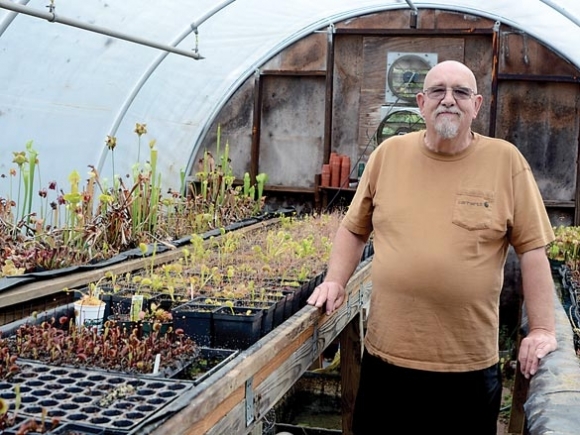Sylva’s carnivorous plant man: After nearly 30 years and thousands of plants, carnivorous plants still fascinate

When it comes to carnivorous plants, Darwin Thomas knows what he’s talking about. It doesn’t take much to get him started on a fact-filled tangent about the plants’ prey preferences, proper care and feeding, or histories. But Thomas, a heating and air technician by trade, didn’t learn any of it by sitting in a class somewhere.
“I read a lot of books, and just talking to people too,” Thomas said. “I’ve not had any education at all in anything to do with this. I just learned over the years. And after 28 years, I think I’ve learned how to grow them.”
That’s probably a fair statement, because today Thomas is the proud father of thousands of carnivorous plants comprising around 20 species and numberless subspecies and varieties. As to the exact number of plants, he says it’s impossible to know for sure. They occupy two greenhouses in the backyard of his home in Sylva, and he’s also got another, smaller, greenhouse at an undisclosed location.
How it started
Thomas, who works fulltime as an HVAC technician at Western Carolina University, blames his transformation into a carnivorous plant fanatic on a seemingly innocuous purchase his wife once made.
“It’s my wife’s fault,” he said. “She bought me a four-inch pot with three plants in it at the Bi-Lo store in Sylva.”
Related Items
Thomas was fascinated and immediately set about finding a book that would teach him more about carnivorous plants. At the time, he could get his hands on only one such book.
That was in 1989. Sylva no longer has a Bi-Lo, and Thomas no longer has a shortage of either carnivorous plants or books about them. He now owns about 50 books on the topic.
Thomas began to dig deeper. He joined the International Carnivorous Plant Society, and when the organization had its first world conference in Atlanta just one year later, he went, taking advantage of the opportunity to chat with carnivorous plant growers from all over the globe.
Then, he started to propagate his own plants — first from seed, then from tissue culture.
“Some of the original plants that I grew from seed I still have, so they’re well over 20 years old,” Thomas said. “I think they’re all perennial, almost every one of them are perennial, so they could live 50 or 60 years maybe — I don’t know how long they’ll live.”
He’s pretty much quit growing from seed, favoring tissue culture instead — it takes about six years for a Venus flytrap grown from seed to get big enough to sell, and about four for a pitcher plant. Tissue culture just about cuts the time in half.
The plant man lifestyle
It was about 10 years into his carnivorous plants hobby that Thomas started to sell them. Like the hobby, the business came about almost by accident.
“I walked out there one day, and the whole backyard was setting there full of pots, and I told my wife, ‘I’m going to have to do something with these things,’” Thomas recalled.
He figured he’d see if he could sell them. Turned out, business was pretty good. He dubbed the enterprise “Darwin’s Backyard Nursery,” with the appropriate tagline “The Bug Stops Here.”
“People are fascinated with them, especially Venus flytraps,” he said. “That’s the one that when I see the children walking along and suddenly they stop and point, that tells me I’m going to have a customer.”
Often, they become repeat customers, because “the number one killer of Venus flytraps is little fingers.” The plants have limited amounts of energy to open and close their traps. When a bug gets caught inside, the trap snaps almost shut and then closes all the way if one of the trigger hairs is touched again within 20 minutes. That’s when the trap closes tight and pumps in chemicals to dissolve the nutrients contained in the bug, feeding the plant a tasty meal and replenishing the energy it spent closing the trap.
But if a flytrap is triggered four times without getting a meal out of the deal — by, for example, a prodding stick wielded by a curious child — it will die. Do that enough times, and all the traps will fall off.
 “After a little while, the whole plant dies. Then I get to sell you a new one next year because the kids done killed the first one,” Thomas laughed.
“After a little while, the whole plant dies. Then I get to sell you a new one next year because the kids done killed the first one,” Thomas laughed.
Thomas mostly sells at garden festivals in the region. Next up is the Cullowhee Native Plant Conference, July 19-22 at WCU. Normally he’d be gearing up for The Whole Bloomin’ Thing in Waynesville, but last year’s drought did a number on his plant inventory. Carnivorous plants need the peat moss where they grow to be saturated if they’re to thrive, and when the rain stopped falling last year, Thomas found that requirement hard to meet — many of his plants died. Next year, though, he plans to have a full schedule of festivals once again.
Thomas’ planned retirement from WCU this fall will hopefully make those plans easier to carry out. The whole time he’s been pampering his inventory of plants, potting them for sale and participating in festivals, Thomas has been working fulltime. About three-and-a-half years ago, however, he switched from day shift to night shift so as to be a better caretaker for his plants. Now, going in at 4 p.m. and getting off at 12:30 a.m., he has all morning to work in the greenhouses and manage sales without taking time off work.
“It’s really satisfying,” Thomas said. “It really gets your mind off of other things when you’re potting and cleaning them up. Sometimes you’ll hear a zzzz zzzz, and I’ll walk around and when I zero in on it I’ll see the trap shaking, and when I see the trap shaking I’ll look back (at the bug inside), and it’s like, ‘Help me, help me.’ I’m like, ‘It’s your own fault, buddy, I didn’t put you in there.’”
Like Venus flytraps, pitcher plants secrete a delicious-smelling nectar to attract bugs. However, the best-smelling nectar is located directly opposite the landing spot, with the cavernous tube of the pitcher in between. This means that all but the longest-legged bugs are likely to fall in as they lean forward to eat the nectar. In addition to tasting good, the nectar is intoxicating, so as the bugs work themselves further and further down, they’re feeling happy and uninhibited and don’t really think about using their power of flight to escape. By the time they reach the bottom, where the digestive juices await, it’s too late.
When bug abundance is high, the plants can do a pretty brisk business.
“Let’s put it this way. The odor is very, very strong,” Thomas said. “I have seen tubes that are well over half-full of bugs.”
To Thomas, the process is fascinating, but he’s also mesmerized by the beauty of the plants. They come in all shapes, sizes and colors — anytime he hears of a new variety, he wants to have it. And, with North Carolina home to more species of carnivorous plants than any other state in the U.S., it seems appropriate that Thomas should have a robust collection.
Right now he does all the work on his own — potting, dividing, cleaning, selling — though he’d love to hire some help if the right person came along. When asked to estimate how many hours he spends with his plants each week, he had a hard time coming up with a number — he’s with them from dawn to dusk Saturday, mornings during the workweek and even a few hours on Sundays.
But that’s not a hardship, at least not for Thomas. The plants are his babies.
“Nobody should be spending that much time with their plants but me,” he said.
Darwin’s Backyard Nursery
Darwin Thomas sells his plants at a variety of shows and festivals throughout the year.
Next up is the Cullowhee Native Plant Conference, which will be held July 19-22 at Western Carolina University, featuring a variety of lectures, walks and field trips in addition to vendors like Thomas. Conference information and registration are online at www.wcu.edu/engage/community-resources/conferences-and-community-classes/the-cullowhee-native-plant-conference.
Contact information for Darwin’s Backyard Nursery is 828.330.4132 or This email address is being protected from spambots. You need JavaScript enabled to view it..
How to make a bog
Carnivorous plants grow best in bogs whose soil is made of low-nutrition peat moss — so the best way to get a plant to grow big fast is to build a bog for it. After nearly 30 years as a carnivorous plant aficionado, Darwin Thomas has the process down.
1. Dig out a space about 12 inches deep.
2. Line the hole with either a layer of 42-millimeter pond liner or two layers of 6-millimeter black plastic. Punch a few holes so water can drain out slowly.
3. Fill the hole with peat moss, also known as sphagnum peat.
4. Add hot water until the peat moss is saturated. Cold water will work but requires about two weeks to absorb into the peat, delaying planting.
5. Plant.
6. Add some landscaping — bushes, stones, pieces of wood — to make it look natural.









